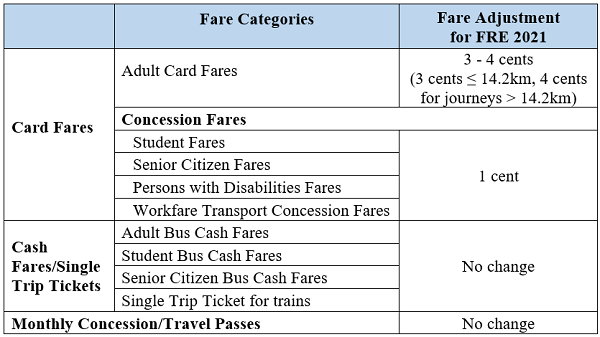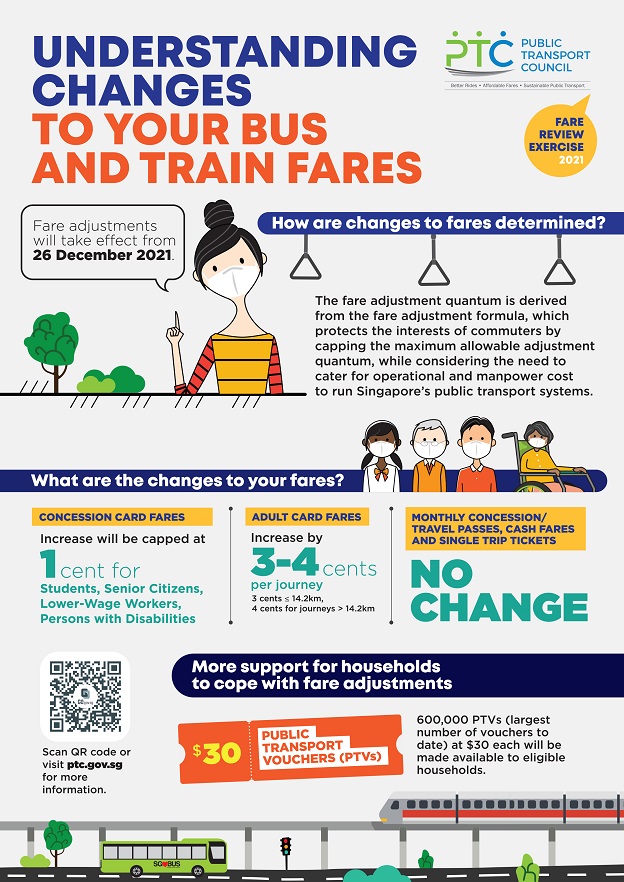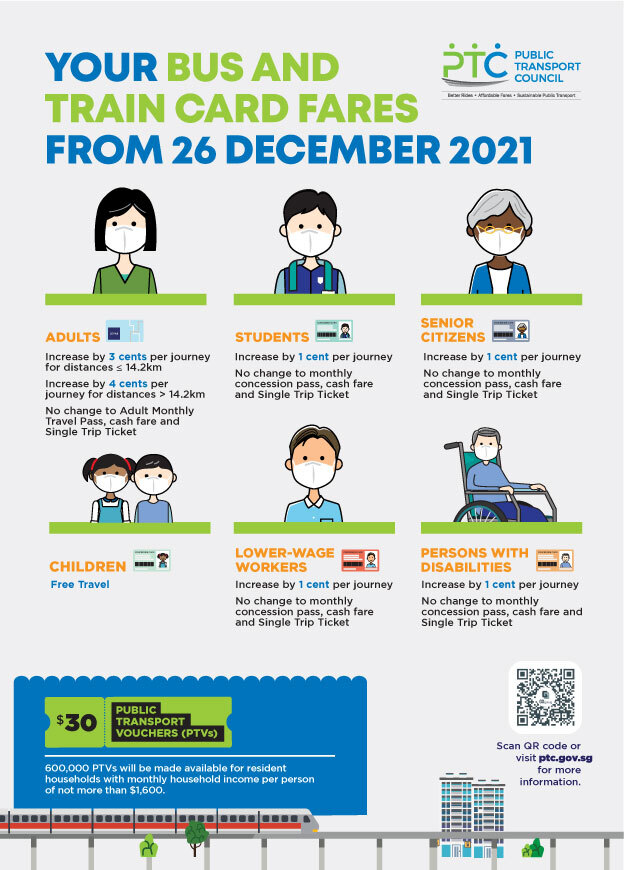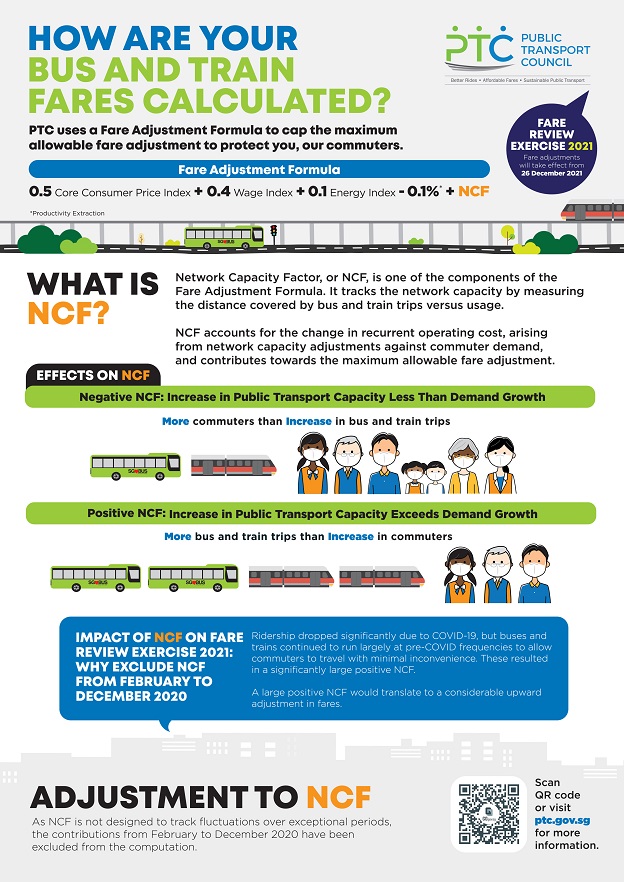2021 Fare Review Exercise
FARE REVIEW EXERCISE 2021
Concession card fares increase capped at 1 cent
Adult commuters to pay 3 to 4 cents more for every journey
Network Capacity Factor from February to December 2020 to be excluded
Largest number of Public Transport Vouchers (600,000) to date to provide support
The Public Transport Council (PTC) recognises the difficult economic circumstances faced by Singaporeans as a result of the COVID-19 pandemic, which have disrupted the daily lives of many Singaporeans. These exceptional circumstances led to our decision to keep bus and train fares unchanged for last year’s Fare Review Exercise (FRE) to help commuters cope with the impact of the pandemic. The Council made the decision to defer last year’s fare adjustment quantum of 4.4% to this year’s exercise.
2 During PTC’s deliberation for FRE this year, one key consideration we had was the public transport ridership in 2020. Since the onset of the COVID-19 pandemic, ridership fell drastically, especially after DORSCON Orange was announced in February 2020, and has remained low compared to pre-COVID-19 levels.
3 Despite the fall in ridership, trains and buses have continued to operate largely at pre-COVID-19 frequencies and also kept to pre-COVID-19 operating hours, so that commuters can travel with minimal inconvenience. In addition, public transport operators have been taking measures to keep commuters safe. These include stepping up cleaning and disinfecting regimes and deploying Service Ambassadors on the ground to promote good public safety practices in the public transport system. These have added significantly to their costs, even as fare revenue decreased because of lower ridership. In 2020, both rail operators would have incurred significant losses if not for the broad-based Government support.
Impact of COVID-19 on Network Capacity Factor Effect
4 One component of the fare formula that has been particularly affected by the drop in ridership is the Network Capacity Factor (NCF). NCF was introduced as part of the fare formula review in 2018 to reflect changes in cost due to enhancements in public transport capacity, such as the expansion of the rail network or running more trains and buses, relative to commuter demand. The NCF will be positive when demand grows slower than capacity. However, the NCF is not designed to track short-term fluctuations in public transport demand and supply during exceptional periods.
5 The lower ridership due to the COVID-19 pandemic would have resulted in a positive NCF as capacity has been kept to pre-COVID-19 level. If computed in full from January 2020 to December 2020, the NCF would have been 50.0%, which is significantly higher than the NCF of 3.9% in FRE 2019 and 1.6% in FRE 2018. An NCF of 50.0% would translate to approximately 60 cents increase in fares if fully factored into the FRE.
6 Given the exceptional circumstances during most of 2020, PTC decided to exclude the NCF contributions from the months of February to December 2020, starting from the announcement of DORSCON Orange. Only January 2020 data compared to the full year of 2019 was used for the computation of NCF in this FRE, before ridership was affected by the COVID-19 pandemic. This resulted in an NCF value of 0.7%, instead of 50.0% for FRE 2021.
Council’s Decision for Fare Review Exercise 2021
7 The output for this year’s fare formula is -2.2%. This helped to moderate the 4.4% carried-over quantum from last year. Hence for FRE 2021, the maximum allowable fare adjustment quantum is 2.2%.
8 PTC has decided to grant the full 2.2% to help mitigate the costs of running public transport services. Moreover, with the recovery of Singapore’s economy1, the operators have also been facing rising cost pressures. Energy prices, in particular, have risen by over 30% for the first half of this year.
9 At the same time, PTC recognises that the pandemic continues to affect Singaporeans and will continue to protect the interests of groups such as senior citizens, lower-wage workers, persons with disabilities and students.
10 Monthly concession/travel pass prices will remain unchanged and the fare increase for concessionary groups will be capped at 1 cent on a per journey basis. This means around two million commuters, or more than half of all Singaporeans, will continue to enjoy subsidised fares of up to 70% off adult fares.2 The prices of the cash fares for buses and single trip ticket for trains will remain unchanged. Adult card fares will increase by 3 to 4 cents (4 cents increase for distances longer than 14.2km).
11 The adjustments in fares, applicable from 26 December 2021, is summarised below:

12 Public Transport Operators are required to make a one-off contribution to the Public Transport Fund as a form of sharing their gains with commuters. Under FRE 2021, PTC will mandate SBS Transit and SMRT to contribute about $2.23 million3 ($0.23 million and $2 million respectively) to this fund.
More support for households to cope with fare adjustment
13 To provide support for households to cope with fare adjustment, the Government will tap on the Public Transport Fund to make available 600,000 Public Transport Vouchers (PTVs). To date, this is the largest number of PTVs set aside with the broadest household coverage, in recognition of the COVID-19 situation. Each PTV is valued at $30 and will help eligible households cushion the impact of the fare adjustment.
A public transport system for current and future generations
14 The Government continues to invest heavily in maintaining a high standard of public transportation. The Government has been providing close to $1 billion per year to renew rail operating assets, and another $1 billion to subsidise bus operations every year. This translates to more than $1 in subsidies for every journey. In 2020, the Government also provided broad-based support measures to help cushion the financial impact faced by public transport operators because of the low ridership and the additional cleaning and manpower costs. The Government will also continue working to enhance the connectivity and reliability of our public transport network for the benefit of all commuters.
15 “The Public Transport Council’s priority has always been to safeguard commuters’ interests, while ensuring a financially sustainable public transport system. This means that bus and train fares would need to be adjusted from time to time. We seek commuters’ understanding that it is not possible to keep deferring fare increases as they are needed to support the rising operating costs, such as energy and wages, for our public transport system. We are mindful that there will be commuters, such as seniors and the lower-wage workers, who might have difficulties to afford any increases. Hence, this is why beyond freezing fares last year, we have continued to protect the concessionary groups and provide support for needy commuters,” said Mr Richard Magnus, Chairman, Public Transport Council.
Annex A: Factsheet for Fare Review Exercise 2021
Annex B: Bus and Train Fares



For more information about the Public Transport Vouchers, please click here.
____________________________________
1 The Ministry of Trade and Industry (MTI) projected Singapore’s GDP growth for 2021 to be at 6% to 7%.
2 The groups which enjoy concession fares are Students, Senior Citizens, Persons with Disabilities (PWD) and Lower-Wage Workers (LWW). In 2014, the Government introduced two concession schemes for LWW and PWD to keep fares affordable for financially needy commuters. In 2019, PTC extended student concessionary fares to polytechnic and other diploma students.
3 Taking into consideration the financial position of rail operators, SBS Transit and SMRT Trains will contribute 5% and 20% of their expected increase in fare revenue to the Public Transport Fund respectively, i.e. $0.23 million for SBS Transit and $2 million for SMRT Trains.
Download 2021 Fare Review Exercise - Annex A and B (PDF, 330 KB)
